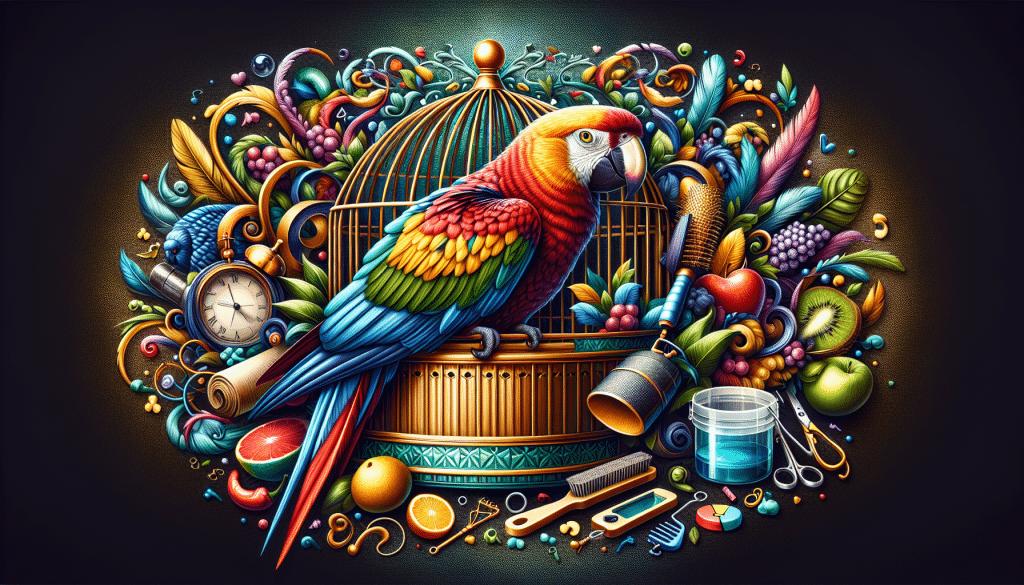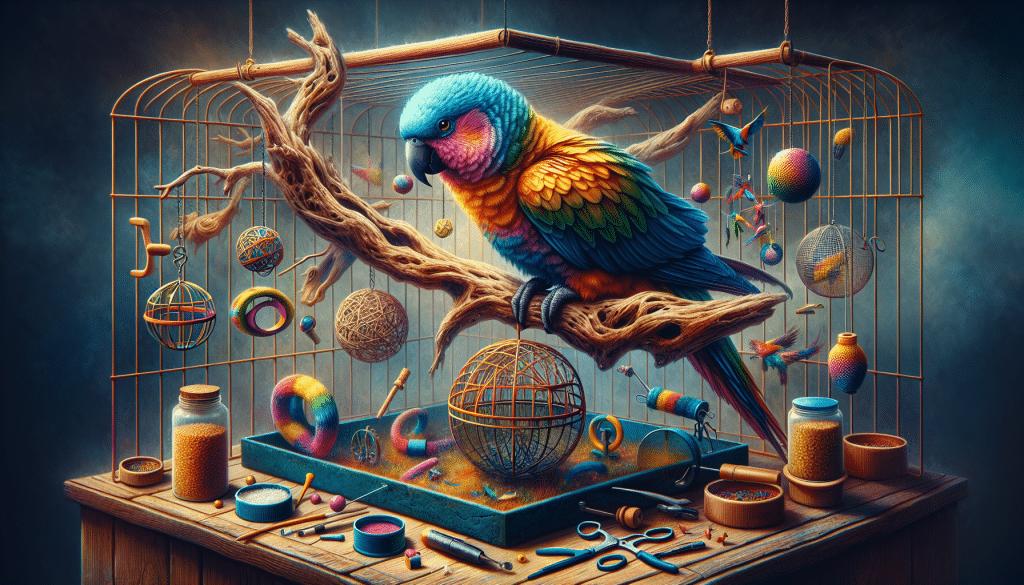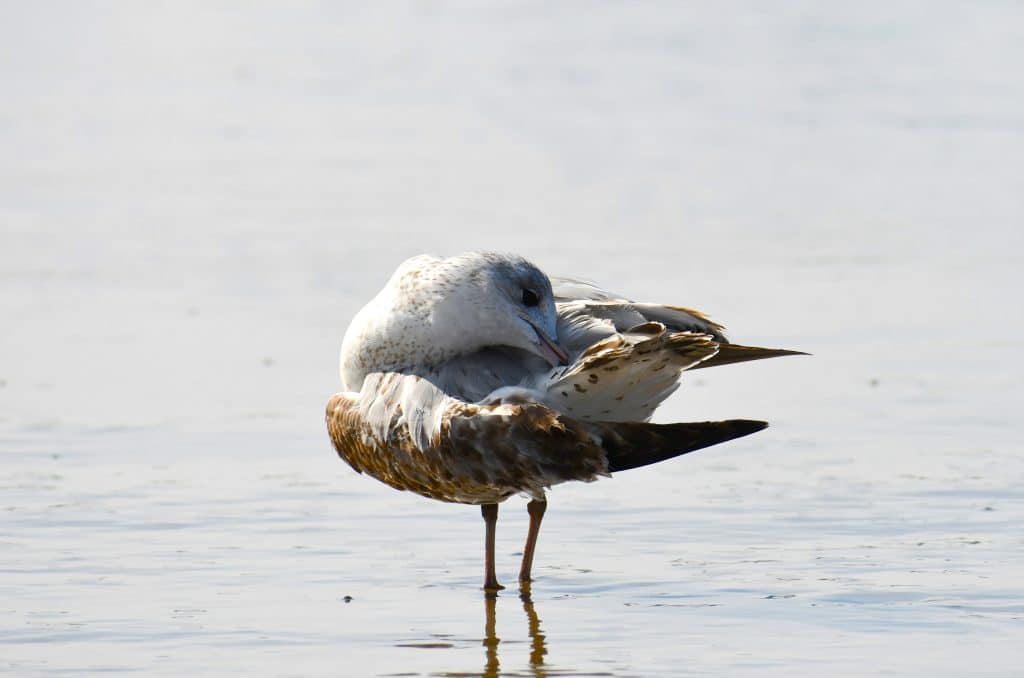Are you a proud owner of a parrot or considering adding one to your family? If so, it’s important to familiarize yourself with essential tips for parrot care and maintenance. These beautiful and intelligent birds require a specific set of needs to thrive in a domestic setting. From providing a proper diet to creating a stimulating environment, this article will guide you through the basics of keeping your feathered friend happy and healthy. So, let’s jump in and explore the world of parrot care and maintenance together!
Choosing the Right Parrot

Understanding Different Parrot Species
When choosing the right parrot for you, it’s important to understand the different species available. Each species has its own unique characteristics, behaviors, and care requirements. From small parakeets to large macaws, there is a wide variety to choose from.
Some of the popular parrot species include budgies, cockatiels, conures, Amazons, African greys, and cockatoos. Budgies and cockatiels are generally smaller in size and known for their playful and social nature. Conures are known for their vibrant colors and playful personalities. Amazons and African greys are highly intelligent and require mental stimulation. Cockatoos are known for their affectionate nature but also require significant time and attention.
By researching and understanding the different species, you can choose a parrot that fits your lifestyle, preferences, and level of commitment.
Assessing Space and Time Commitments
Owning a parrot requires adequate space and time commitments. Parrots need a spacious and comfortable living environment where they can spread their wings, climb, and play. It is essential to select a cage that provides enough space for the bird to move freely. The cage should also include perches, toys, and feeding bowls.
In addition to space, parrots also require significant time and attention from their owners. Parrots are highly social creatures and need daily interaction and mental stimulation. They thrive on companionship and can become distressed or even develop behavioral issues if left alone for long periods.
Before bringing a parrot into your life, evaluate your living space and your daily schedule to ensure you can provide the necessary space and time commitments for their well-being.
Considering Adoption from Rescues or Shelters
Adopting a parrot from a rescue or shelter is a wonderful option for those looking to provide a loving home to a bird in need. Many parrots end up in rescues or shelters due to various reasons, such as changes in the owner’s circumstances or the inability to meet their needs.
When considering adoption, it’s important to do thorough research on the rescue or shelter you are interested in. Find out about their adoption policies, the type of parrots available, and their medical history if possible. Additionally, spend time interacting with the parrot you are considering adopting to ensure compatibility and a good bond.
By adopting a parrot, not only are you providing a forever home for a bird in need, but you are also supporting the efforts of rescues and shelters in improving the welfare of parrots.
Essential Parrot Nutrition
Balanced Diet for Different Parrot Species
Providing a balanced diet is crucial for the health and well-being of your parrot. Different parrot species have different dietary needs, and it is important to understand and cater to these needs.
A well-balanced diet for parrots typically consists of a variety of fresh fruits and vegetables, high-quality pellets or seeds, and occasional treats. Each species may have specific preferences and dietary restrictions, so it is important to research and consult with avian veterinarians or experienced bird owners to ensure you are providing the right nutrition.
Offering a diverse range of foods ensures that your parrot receives all the essential nutrients, including vitamins, minerals, and proteins. Avoid feeding them toxic or harmful foods such as chocolate, avocado, caffeine, and alcohol, as these can be deadly for parrots.
Safe Foods and Dangerous Foods for Parrots
While it is important to provide a wide variety of safe foods for your parrot, it is equally important to be aware of foods that can be toxic or harmful to their health. Some common foods that are safe for parrots include apples, bananas, carrots, broccoli, and leafy greens. These foods provide essential vitamins and minerals.
On the other hand, there are foods that should never be fed to parrots as they can be toxic or pose a choking hazard. These include chocolate, avocado, caffeine, alcohol, onions, garlic, and any foods that have been seasoned with salt or spices.
To keep your parrot healthy and safe, familiarize yourself with the list of safe foods and avoid feeding them anything that could potentially harm them.
Importance of Fresh Water and How to Provide It
Water is essential for the overall health and hydration of your parrot. Ensure that clean and fresh water is always available to your parrot. The water bowl should be cleaned and refilled daily to prevent the growth of bacteria. Make sure the water bowl is easily accessible and positioned in a location where it will not get contaminated by food or droppings.
Consider using a water bottle designed specifically for birds, as this helps prevent the water from becoming contaminated. Regularly check the water bottle nozzle to ensure it is not clogged or leaking.
In addition to providing fresh water, consider supplementing your parrot’s diet with moisture-rich foods such as fruits and vegetables to ensure they are well-hydrated.
Creating a Suitable Habitat
Selecting the Appropriate Cage Size and Style
The cage is your parrot’s habitat, and it is essential to select the appropriate size and style for their well-being. The cage should be spacious enough for your parrot to move around, stretch its wings, and climb without feeling confined. As a general rule, the cage should be at least double the wingspan of the fully spread wings of your parrot.
Choose a cage made of safe and non-toxic materials such as stainless steel or powder-coated metal. Avoid cages made from materials that could be harmful if ingested, such as lead or zinc.
Consider the bar spacing of the cage to ensure your parrot cannot squeeze through or get stuck between the bars. The cage should also have a properly secured door to prevent any accidental escapes.
The Role of Perches and Cage Placement
Perches play a vital role in your parrot’s cage habitat. Provide a variety of perches of different sizes and textures to promote foot health and exercise. Natural wood perches are recommended as they provide different textures for your parrot to grip and chew on. Avoid using sandpaper perch covers as they can cause abrasions on your bird’s feet.
When choosing the placement of the cage, ensure it is in a well-lit area but away from direct sunlight or drafts. Parrots are social creatures and enjoy being part of the family, so place the cage in an area where they can observe and interact with the household activities.

Temperature, Lighting, and Humidity Control
Maintaining the right temperature, lighting, and humidity is essential for the health and well-being of your parrot. Most parrots thrive in temperatures between 65-85°F (18-29°C). It is important to avoid exposing your parrot to extreme temperatures or rapid temperature fluctuations.
Provide a source of full-spectrum lighting to ensure your parrot receives sufficient vitamin D3 for its overall health. Natural sunlight is the best option, but if that is not possible, consider using full-spectrum UVB bulbs designed specifically for birds.
Humidity levels should be kept within the appropriate range for your specific parrot species. Some species require higher humidity levels, while others prefer drier environments. Research the humidity requirements for your parrot’s species and provide a suitable environment accordingly.
Cage Hygiene and Maintenance
Routine Cleaning Schedule
Maintaining a clean and hygienic cage is essential for the health and well-being of your parrot. Establish a routine cleaning schedule to ensure the cage is regularly cleaned. Daily tasks include removing any uneaten food, replacing soiled bedding or papers, and wiping down surfaces.
On a weekly basis, thoroughly clean the cage using a bird-safe cleaner or a mild dish soap. Remove all the accessories, including perches, toys, and dishes, and clean them separately. Rinse everything thoroughly to remove any trace of cleaning products.
Additionally, conduct a monthly deep clean of the cage, including disinfecting the cage bars and scrubbing any hard-to-reach areas. Regular cleaning helps prevent the buildup of bacteria, mold, and parasites.
Disinfecting the Cage and Accessories
Regular disinfection of the cage and accessories is important to keep your parrot’s living environment free from harmful bacteria and parasites. Use a bird-safe disinfectant or a mixture of vinegar and water to sanitize the cage bars, perches, toys, and feeding dishes.
Before returning the accessories to the cage, ensure they are completely dry to prevent the growth of mold. Disinfecting regularly helps maintain a healthy and hygienic living space for your parrot.
Managing Waste and Avoiding Contamination
Proper waste management is crucial to maintain a clean and healthy environment for your parrot. Place a liner at the bottom of the cage to collect droppings, food debris, and feathers. Regularly remove and replace the liner to prevent the accumulation of waste and the growth of bacteria.
To avoid contamination, separate the food and water dishes from areas where your parrot may defecate. Position them in a way that prevents droppings from contaminating the food and water. Make sure to clean and disinfect the food and water dishes daily to maintain hygiene.
By effectively managing waste and avoiding contamination, you can create a safe and healthy living space for your parrot.
Enrichment and Mental Stimulation
Toys and Entertainment for Parrots
Parrots are intelligent and curious creatures that require mental stimulation to prevent boredom and promote overall well-being. Provide a variety of toys and entertainment options to keep your parrot mentally engaged.
Toys that encourage foraging and problem-solving are particularly beneficial for parrots. Puzzle toys, foraging wheels, and treat-dispensing toys can provide hours of mental stimulation. Rotate the toys regularly to keep your parrot interested and prevent them from becoming bored with their environment.
It is important to select toys made from safe and non-toxic materials. Avoid toys with small parts that can be easily chewed off and swallowed. Supervise your parrot when introducing new toys to ensure they are being used safely.
Training and Cognitive Challenges
Training your parrot not only strengthens the bond between you and your feathery friend but also provides mental stimulation and a sense of accomplishment for your parrot. Basic commands, such as “step-up” and “come here,” can be taught using positive reinforcement techniques.
In addition to training, provide your parrot with cognitive challenges to keep their mind active. This can include teaching them to solve simple puzzles or hiding treats for them to find. Engage in interactive playtime and games that stimulate their natural instincts, such as fetching or target training.
Learning new tricks and skills not only keeps your parrot mentally stimulated but also enhances their overall well-being.
The Importance of Social Interaction
Parrots are highly social animals and require regular social interaction with their owners. Spend quality time with your parrot daily, engaging in activities such as talking to them, singing, playing games, or simply offering them physical contact.
Parrots can become lonely and develop behavioral issues if they are not provided with sufficient social interaction. If you are unable to spend a lot of time with your parrot, consider getting them a companion bird or enlisting the help of a trusted bird sitter or caregiver.
Building a strong bond through regular social interaction is essential for the emotional well-being of your parrot.
Handling and Bonding Techniques
Steps to Safely Handle Your Parrot
Handling your parrot safely and properly is important for their safety and well-being, as well as for building a strong bond with them. Follow these steps to ensure safe handling:
- Approach your parrot calmly and confidently, avoiding sudden movements.
- Offer your hand, palm facing upwards, as a perch for your parrot to step onto.
- Allow your parrot to approach and step onto your hand willingly. Do not force them.
- Lift your parrot gently and support their body using your other hand if necessary.
- Avoid squeezing or gripping your parrot too tightly. They should feel secure but not restricted.
Regular practice and positive reinforcement will help your parrot become more comfortable with handling and build a trusting bond with you.

Building Trust Through Daily Interaction
Building trust with your parrot is a gradual process that requires patience and consistency. Daily interaction and positive reinforcement are crucial for developing a strong bond.
Spend time talking to your parrot, offering treats, and engaging in activities they enjoy. Respect their boundaries and never force them into uncomfortable situations. Allow them to approach you at their own pace, and avoid any actions that may scare or distress them.
Consistency in your behavior and approach will help your parrot feel secure and develop trust in you as their caregiver.
Recognizing and Respecting Parrot Body Language
Understanding your parrot’s body language is key to maintaining a positive and respectful relationship. Parrots communicate through a variety of behavioral cues, and being able to interpret these cues can help you meet their needs and avoid potential conflicts.
Some common parrot body language cues include:
- Feather position: Fluffed feathers may indicate relaxation or discomfort, while sleek feathers indicate contentment or alertness.
- Eye shape and size: Wide eyes may indicate fear or surprise, while relaxed eyes indicate comfort.
- Body posture: An upright posture with raised feathers may indicate aggression or territoriality, while a relaxed posture with feathers at rest indicates comfort.
- Vocalizations: Different vocalizations can convey various emotions such as excitement, fear, or contentment.
By observing and respecting your parrot’s body language, you can better understand their needs and provide a safe and nurturing environment.
Health Care and Regular Check-Ups
Finding an Avian Veterinarian
Regular health check-ups with an avian veterinarian are essential for your parrot’s well-being. When choosing an avian veterinarian, consider their experience and knowledge in avian medicine. They should have a good reputation and be familiar with the specific needs and health issues of parrots.
Ask for recommendations from other bird owners or local bird clubs. Research the qualifications and credentials of potential veterinarians, and consider scheduling a consultation to discuss your parrot’s health care needs.
Establishing a good relationship with a trusted avian veterinarian ensures your parrot receives proper medical care throughout their life.
Common Parrot Diseases and Prevention
Parrots are susceptible to various diseases, and it is important to be aware of common health issues and take preventive measures to keep your parrot healthy.
Some common diseases that affect parrots include respiratory infections, psittacosis, feather plucking, and nutritional deficiencies. Regularly monitor your parrot for any signs of illness, such as changes in behavior, eating habits, or appearance. If you notice any abnormalities, seek veterinary care immediately.
Preventive measures include providing a healthy diet, maintaining a clean and hygienic living environment, and avoiding exposure to other sick birds. Regular veterinary check-ups and vaccinations, where applicable, also play a crucial role in preventing disease.
The Importance of Regular Health Assessments
Regular health assessments are vital to identify potential health issues early and ensure prompt treatment. Schedule regular check-ups with your avian veterinarian to monitor your parrot’s overall health and identify any underlying health concerns.
During these assessments, the veterinarian will conduct a physical examination, check for signs of illness or abnormalities, and may recommend additional tests or procedures if necessary. They may also offer advice on nutrition, hygiene, and general care based on their findings.
Regular health assessments help maintain your parrot’s health and well-being, and are an essential part of responsible parrot ownership.
Molting and Grooming
Understanding Molting Process in Parrots
Molting is a natural process in which parrots shed and replace their feathers. It usually occurs once or twice a year and can last for several weeks. During molting, parrots may appear scruffy, lethargic, or less active than usual.
Molting is an essential part of feather maintenance and growth. It allows parrots to replace old or damaged feathers and ensures they maintain a healthy plumage. During this time, parrots may require additional nutrients, such as protein and vitamins, to support feather growth.
Provide your parrot with a balanced diet and ensure they have access to fresh water during the molting period. Gently brush your parrot’s feathers with a soft brush to help remove any loose feathers and prevent tangling.
Grooming Needs: Beak, Nails, and Feathers
Regular grooming is important to maintain your parrot’s beak, nails, and feathers. Beaks naturally grow and can become overgrown if not properly maintained. Provide your parrot with appropriate chew toys and mineral blocks to help naturally wear down their beaks. If necessary, consult with your avian veterinarian for professional beak trims.
Trimming your parrot’s nails is also necessary to prevent overgrowth and potential injury. Some parrots may require more frequent nail trims than others, depending on their activity level. Consult with your avian veterinarian or a professional bird groomer to learn how to safely trim your parrot’s nails or seek professional assistance if you are uncomfortable doing it yourself.
Feather care involves ensuring they are clean and in good condition. Regular preening, provided by your parrot or through gentle brushing, helps maintain healthy feathers. If you notice any abnormalities, such as feather plucking or bald patches, seek veterinary advice to address the underlying cause.
Bathing and Dust Baths: How and When
Bathing is an important part of maintaining your parrot’s feather health and hygiene. Some parrots may enjoy taking a bath while others prefer misting or being sprayed with water. Offer your parrot a shallow dish of water or use a spray bottle to gently mist them. Observe their comfort level and adjust accordingly.
Alternatively, dust baths can be beneficial for parrots that prefer not to get wet. Provide a shallow dish with bird-safe dusting material, such as cornstarch or bird-specific bathing powder. Your parrot will roll around in the dust, which helps remove excess oils and keeps their feathers clean.
Bathing or dust baths should be offered regularly, depending on your parrot’s preferences and needs. Always ensure the water or dust is clean, and monitor your parrot to ensure they are enjoying the bathing experience.
Understanding Parrot Behavior
Common Behavioral Issues and Solutions
Like any pet, parrots can exhibit certain behavioral issues that may need to be addressed. Some common behavioral issues in parrots include biting, screaming, feather plucking, and aggression.
These behaviors can have underlying causes such as lack of socialization, boredom, improper diet, health issues, or environmental stress. Identifying and addressing the root cause is crucial in effectively managing these behavioral issues.
Consult with an avian veterinarian or a certified bird behaviorist to help diagnose the cause and develop a behavior modification plan specific to your parrot’s needs. Positive reinforcement training, environmental enrichment, and addressing any potential health concerns can all contribute to resolving behavioral issues.
The Impact of Hormonal Changes
Hormonal changes can significantly impact a parrot’s behavior and overall well-being. During breeding season or hormonal peaks, parrots may exhibit increased territoriality, aggression, or become more vocal.
Providing a consistent environment and routine can help minimize hormonal fluctuations. Creating a predictable daily schedule and avoiding certain triggers, such as excessive petting or nest-like bedding, can help reduce hormonal behavior.
Ensure your parrot receives proper mental and physical stimulation to alleviate hormonal frustration. Consult with an avian veterinarian or an experienced bird behaviorist for additional guidance on managing hormonal changes in your parrot.
Interpreting Vocalizations and Body Language
Parrots communicate through a combination of vocalizations and body language. Understanding and interpreting these cues is key to meeting their needs and maintaining a healthy and happy parrot.
Vocalizations can range from singing and talking to screeching and squawking. Each vocalization can convey different emotions or messages, such as excitement, fear, attention-seeking, or warning. Observe your parrot’s body language and their environment to better understand the context of their vocalizations.
Body language cues include wing position, feather position, eye size, perch position, head movements, and overall posture. These cues can provide insight into your parrot’s mood, comfort level, and potential stressors. Regularly observe and interact with your parrot to become familiar with their unique vocalizations and body language.
By understanding your parrot’s vocalizations and body language, you can better meet their needs and maintain a strong bond with them.
Legal and Ethical Responsibilities
Adherence to Wildlife and Pet Ownership Laws
Owning a parrot comes with legal and ethical responsibilities. Familiarize yourself with local, state, and national laws concerning the ownership and care of pet parrots. These laws aim to protect both the welfare of the parrots and the environment.
Some jurisdictions may require permits or licenses for owning certain parrot species. Others may have restrictions on the capture and trade of wild-caught parrots. Strive to comply with these laws to ensure responsible parrot ownership and support conservation efforts.
Ethical Breeding Practices
Breeding parrots should be done responsibly and with ethical considerations. Breeding should only be undertaken by experienced and knowledgeable individuals who can provide proper care and support to the breeding pair and their offspring.
Avoid supporting or participating in any unethical breeding practices, such as overbreeding or commercial breeding operations. These practices can contribute to the overpopulation of parrots in captivity and lead to the mistreatment and neglect of these intelligent creatures.
Consider adopting parrots from rescues or shelters instead of supporting breeding practices. By adopting, you provide a forever home for a parrot in need and contribute to the well-being of these amazing creatures.
The Impact of the Exotic Pet Trade on Parrot Welfare
The exotic pet trade has a significant impact on the welfare of parrots. Many parrots are captured from the wild or bred in captivity for the purpose of the pet trade. These practices can lead to stress, disease, and improper care for the birds.
Supporting responsible practices and avoiding purchasing parrots from illegal or unethical sources is crucial. Look for reputable breeders or consider adopting from rescues and shelters. By supporting ethical practices and providing a loving home to a parrot, you can make a positive difference in their welfare.
In conclusion, choosing the right parrot involves understanding the different species, assessing space and time commitments, and considering adoption from rescues or shelters. Essential parrot nutrition includes providing a balanced diet, knowing safe and dangerous foods, and ensuring access to fresh water. Creating a suitable habitat involves selecting the appropriate cage size and style, understanding the role of perches and cage placement, and maintaining proper temperature, lighting, and humidity. Cage hygiene and maintenance require a routine cleaning schedule, disinfecting the cage and accessories, and managing waste to avoid contamination. Enrichment and mental stimulation are achieved through providing toys and entertainment, training and cognitive challenges, and the importance of social interaction. Proper handling and bonding techniques involve steps to safely handle your parrot, building trust through daily interaction, and recognizing and respecting parrot body language. Health care and regular check-ups involve finding an avian veterinarian, common parrot diseases and prevention, and the importance of regular health assessments. Molting and grooming encompass understanding the molting process, grooming needs for beaks, nails, and feathers, and bathing and dust baths. Understanding parrot behavior involves common behavioral issues and solutions, the impact of hormonal changes, and interpreting vocalizations and body language. Finally, legal and ethical responsibilities encompass adherence to wildlife and pet ownership laws, ethical breeding practices, and the impact of the exotic pet trade on parrot welfare.
By following these comprehensive guidelines, you can provide the best possible care for your parrot, ensuring their health, happiness, and well-being for years to come.



